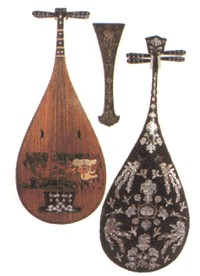1) Pipa


琵琶
1.
About the Tone Variation in Pipa Performance;


谈琵琶演奏中的音色变化
2.
Heart-striking Tunes: An Analysis of Pipa Rhyme Adapted from a Tang Dynasty Poem;


千古绝唱沁心扉 抑扬跌宕谱新声——琵琶独奏曲《诉——读唐诗<琵琶行>有感》赏析
3.
The Classification and Comprehensive Application of the Tone Color of Pipa;


琵琶音色的分类解析与综合应用
2) lute
[英][lu:t] [美][lut]


琵琶
1.
The Comparison Study on the Lute Arts of Pudong School and Wang School;


浦东派、汪派琵琶艺术比较研究
2.
In Qin Dynasty, lute refers to a straight-neck drum with a sound box-also called Qin-Lute,first round,then,pear-shaped.
琵琶,在古代是所有弹弦乐器的总称。
3.
The music art of lute (a plucked string instrument with a fretted fingerboard) came from the minorities in the west region in the Tang dynasty, giving the audiences and scholars in the central region unusual novel feelings.
唐代传自西域的琵琶艺术,为当时的中原听众平添了异样的新奇之感,因而博得了文人学士的喜好,写作了大量有关琵琶的诗歌。
3) Biwa lake


琵琶湖
1.
The precious experiences on protecting and treating Biwa lake are concluded by field visit.
对日本成功治理琵琶湖在环境保护和治理方面宝贵经验进行了总结,包括污染源控制和生态修复技术、环境管理、公众参与和科学研究等方面的内容,供我国众多富营养化湖泊治理借鉴和参考。
2.
The administered experiences of Japanese biwa lake water environment were introduced.


介绍了日本琵琶湖水环境的治理经验。
4) Lake Biwa


琵琶湖
1.
Inspiration of management experiences of Lake Biwa to Dongting Lake;


日本琵琶湖治理经验对洞庭湖的启示
2.
Inspirations to treatment of Taihu Lake by technical measures of Lake Biwa in Japan;


日本琵琶湖治理的技术措施对太湖的启示
3.
Comment on basic idea for protection and regulation of Lake Biwa of Japan;


日本琵琶湖保护治理的基本思路评析
5) The Story of Lute


《琵琶记》
1.
From Nanxi Chaste Women Zhao and Erlang Cai to Chuanqi The Story of Lute;


从南戏《赵贞女蔡二郎》到传奇《琵琶记》
2.
Taking the general discussion of 1956 as study case, this article aims to investigate the charm of The Story of Lute as classics and its value as an exemplification of the past serving the present in the contemporary cultural environment.
本文以1956年的《琵琶记》大讨论为个案,探讨《琵琶记》的经典魅力以及其作为“古为今用”的范例在当代文化境遇中的价值。
3.
They collaborated in comment on The Romance of the Three Kingdoms and opera the Story of Lute.
毛氏父子先后合作完成了小说《三国演义》的批评和戏曲《琵琶记》的批评。
6) PIPAJI


琵琶记
1.
On the Interrogative Sentences in Spoken Parts in the YUAN Version of PIPAJI;


元本《琵琶记》宾白中的疑问句
2.
The Decline of PiPaJi——the Famous Literature Works?;


《琵琶记》,经典缘何衰落?
补充资料:琵琶
| 琵琶 中国拨奏弦鸣乐器。初以演奏方法而名为“批把”,即右手向前弹出曰“批”,向后弹进曰“把”。凡抱在怀中用此法弹奏的乐器,早期都称琵琶。 在中国历史上 ,琵琶有圆形音箱和半梨形音箱两类。圆形音箱的琵琶,相传为秦代在鼗鼓(拨郎鼓)上安弦而改其为拨弦乐器,称弦鼗,后世称秦琵琶。到汉代定型为4弦12品,用手弹拨。汉代解忧公主带到西域,又名汉琵琶。晋代阮咸以擅弹此乐器出名,后人又称为阮咸琵琶,简称阮。秦琴、月琴、三弦、双清等属此系统。半梨形音箱的琵琶于4世纪由印度传入。曲颈,颈上4相,用拨子弹奏。为区别于当时的直柄圆形汉琵琶,故名曲颈琵琶;又因传入地称龟兹琵琶。5弦、6弦、2弦琵琶(忽雷)及火不思等属此系统。宋代以后,曲颈琵琶名琵琶,汉琵琶名阮咸。
隋唐时曲颈琵琶颇为流行 。至明代,已发展为4相9品,19世纪初为4相10品,20世纪初增为12品 ,音域扩大至3个八度。演奏方法也改横弹为竖弹,以5个手指代替拨子弹奏,扩展了该乐器的演奏技法和表现力。30年代初又增为6相18品,现为6相25品,半音齐全,广泛应用于歌、舞、曲艺、戏曲的伴奏,以及器乐合奏、重奏和独奏。 琵琶独奏曲有大曲、小曲之分。大曲又称大套,多为多段形式的紧密有机整体或小曲联套形式。大曲中又有文、武曲之别。文套风格秀雅,如《夕阳箫鼓》、《汉宫秋月》;武套气概雄健,如《十面埋伏》、《海青拿天鹅》。小曲又称小套,通常为68板结构。 |
说明:补充资料仅用于学习参考,请勿用于其它任何用途。
参考词条
